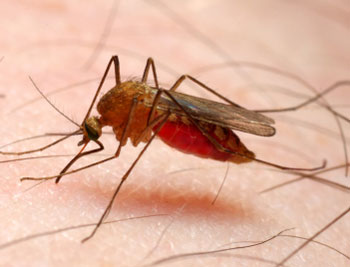Tiny Mosquito
Dangers of the Anopheles Mosquito
With approximately 460 different species living on the planet, the mosquito known as the Anopheles has been evolving since it came into existence over 150 million years ago. Despite their very short live span, certain species of the Anopheles mosquito are highly devastating to the human population.
Out of the 460 species of Anopheles, about 60 have been documented as having transmitted malaria to humans. In certain areas of the world, specific species of Anopheles are prevalent. Some dangerous onrs include the A. freeborni in North America, A.gambiae in Africa, and approximately 45 different kinds in India.
 What Types
of Diseases does the Anopheles Mosquito Carry?
What Types
of Diseases does the Anopheles Mosquito Carry?
The Anopheles is well known for spreading illnesses to humans,
the most dangerous one being malaria which has killed hundreds of millions
of people worldwide, and continues to kill over one million individuals
each year. Malaria is transmitted to humans by the female mosquito which
requires a blood meal to provide nourishment to her eggs after mating.
Once the female bites an infected human, she will then transmit the malarial
parasites to the next person she feeds on.
The Anopheles mosquito is also capable of transmitting filarial worms, various arboviruses, onyong-nyong, tataguine, equine encephalitis, as well as other viruses, but malaria is unquestionably the most threatening.
The Life Cycle of the Anopheles Mosquito
With a life span of about 1 to 3 weeks, the Anopheles mosquito
goes through four stages before it dies: egg, larva, pupa, and imago (adult).
Once the male has mated with the female, she must find a blood meal for
sustenance before laying her eggs. Thereafter, she will deposit roughly
70 to 100 eggs on the surface of water during the night. In about a week’s
time, the eggs hatch and the Anopheles larvae remain under water, feeding
on algae for approximately 7 to 14 days before turning into pupae. After
a few days, the pupae become adult mosquitoes and are able to fly in a
matter of minutes.
Where to Find the Anopheles Mosquito
The Anopheles mosquito favors areas that harbor an abundance
of natural water in order to breed. You can expect to find these mosquitoes
and their larvae in ponds, marches, swamps, ditches, rain pools, and on
the shores of streams and rivers. Some breed in shady areas such as forests,
while others breed in open fields where there is plenty of sunlight.
It is also possible to find the Anopheles in rural and urban areas. Used
tires, flower pots, rain barrels, buckets, and other objects that collect
water are ideal places for mosquitoes to populate. Eliminating these items
from your property can help prevent the breeding of mosquitoes near your
home.
Home - Mosquitoes - Bites - Control - Diseases - Resources - Site Map